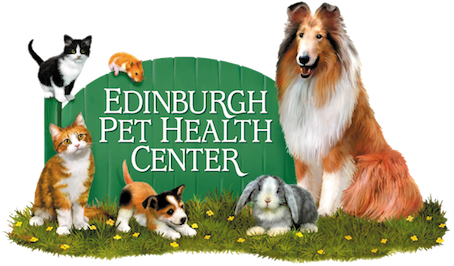Successful weight reduction for your pet
“Winter weight”. “He is just big boned.” We’ll do more walking now that the weather is warmer.” “We don’t give any treats.” “My husband insists on giving tablescraps”. Whatever the reason, your pet is still overweight and now is the time to correct the problems leading to it. Obesity is the most common health problem affecting dogs and cats, reducing their life-span and contributing to several serious problems, including diabetes, heat intolerance, heart disease, arthritis and also lower urinary problems in cats Approximately 50% of our pets are overweight or obese. We are simply loving them to death with food. Fortunately, obesity is treatable. Its successful resolution depends on dietary changes, increased physical activity and a renewed determination to do things differently to avoid diet failure.
Causes
Some overweight pets suffer from identifiable diseases or physical problems that have caused their obesity. These problems include hormonal imbalances such as hypothyroidism and Cushings disease, certain brain lesions and certain types of tumors. For this reason, a thorough physical examination is mandatory for all obese animals to uncover any medical problems. In addition, other screening tests may also be recommended.
Certain dog breeds appear to be predisposed to excessive weight gain, including Cocker Spaniels, Labrador Retrievers, Dachshunds, Shelties, Beagles, Bassett Hounds, and Cairn Terriers.
Spayed and neutered pets have lowered metabolic rates and are at risk of weight gain if the caloric intake is not reduced after they are altered.
In the vast majority of cases obesity is the result of overeating, lack of exercise or both. For these animals, it is up to the owner to help their pet overcome this problem.
Treatment
Restricting caloric intake using the pet’s normal diet is rarely successful. Usually the pet becomes so hungry it cries or begs or seeks other sources of food. Such behavior is unacceptable to the owner who gives in and returns to the old feeding habits. Special diets such as Metabolic diet, r/d, Eukanuba Restricted Calorie and Purina OM are designed for weight loss and are more successful in attaining weight loss in pets. These diets are designed to maintain critical protein levels and the correct vitamin and mineral levels despite the low calorie nature of the food. In addition, some cats will benefit from canned, high protein diets designed for weight loss.
It is important to be aware of all calories fed to the pet. Treats, table foods, other pet’s food and training rewards ALL need to be accounted for in the total calories allowed during the day. Feeding free-choice food is NOT recommended. Pets on a diet should be meal-fed and separated if necessary from other pets. Choose low calorie treats whenever possible.
To monitor your pet’s weight loss, we encourage you to return for regular weigh-ins, at least monthly, to be sure weight loss is occurring. If no weight loss is seen after one month, the caloric intake should be restricted by an additional 20%.
Dog food calorie values
- Metabolic Diet-Canned: 319 kcal/can
- Metabolic dry: 252 kcal/cup
- r/d canned: 257 Kcal/can
- r/d dry: 242 Kcal/cup
- Eukanuba Restricted Calorie dry: 217 Kcal/cup
- Science Diet Light-dry: 295 Kcal/cup
- Purina Fit-N-Trim-dry: 365 Kcal/cup
- Purina OM: 276 kcal/cup
Cat food calorie values
- Metabolic Diet-canned-129 kcal/can
- Metabolic Diet -dry-298 Kcal/cup
- m/d-canned-156 Kcal/can
- m/d dry-495 Kcal/cup
- r/d canned-114 Kcal/5.5 oz. can
- r/d dry-263 Kcal/cup
- Eukanuba Restricted Calorie dry – 268 Kcal/cup
- Science Diet Light-dry-316 Kcal/cup
Treats
It is recommended that calories from treats do not exceed 20% of daily calorie intake. Treats should be put in a labeled baggie each day and when they are gone, no other treats given until the next day. Below are some common treats and their calorie values.
- Milkbones:
- small: 20 Kcal
- medium: 40 Kcal
- large: 115 kcal
- Green beans: 40 kcal/cup (14.5 oz can-70 kcal)
- Carrots: 52 Kcal/cup
- Apple: 1 medium: 95 Kcal
- Rice cakes: minimal calories
- Unbuttered popcorn: minimal calories
- Eukanuba low cal treat: 13 Kcal/treat
Weight loss program sample
Below is a sample weight loss program, as well as the guidelines we use for our patients. We recommend consulting with a veterinarian before beginning any weight reduction regimen so we can factor in any other health issues specific to your pet.
WEIGHT LOSS PROGRAM FOR:____________________________
CURRENT WEIGHT (a)________#
DESIRED WEIGHT (b)________#
WEIGHT LOSS EXPECTED (c)________#
DIET TO BE FED_____________________
QUANTITY TO BE FED/DAY____________
[(d) divided by Kcal/cup of food (listed on bag of food) = # of cup or cans/day to feed]
*MAKE SURE TO MIX YOUR PET’S CURRENT FOOD WITH THE NEW DIET FOR 3-5 DAYS BEFORE COMPLETELY SWITCHING OVER.
Weight reduction for dogs
Time required for weight reduction _____weeks
[(c) divided by weight loss/wk( per table below)]
If optimum body weight (b) is:
1-20#-lose 0.5 #/wk
20-40#-lose 1.0 #/wk
>40#-lose1.5#/wk
Kcal/day for reduction
____________(d) (total for all foods, treats)
RER (resting energy requirement)=[70+30(optimal body weight in kg)]
Weight reduction for cats
Time required for weight reduction _____weeks
[(c) divided by 0.25]
Kcal/day for reduction
____________(d) (total for all foods, treats)
Kcal/day=60-70% of optimal body weight MER (maintenance energy requirement).
RER (resting energy requirement)=0.8[70+30(optimal body weight in kg)]
